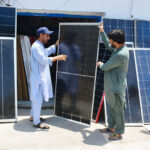By Fakhar Alam
PESHAWAR, Jul 14 (APP):The population bulge and technological advancement have exerted pressure on energy resources where its shortfall has touched a record 7,000 megawatts (MW) that negatively impacted the national economy, agriculture and industrial growth.
As the country’s population has crossed the psychological barrier of 240.954 million mark in May this year which means that new water dams and promotion of run-of the river (ROR) hydroelectricity would be required to bridge the widening demand-supply gap of electricity. It would help fulfil the pressing demands of affordable energy of the consumers that was increasing with each passing day in the wake of mushroom growth of IT and agriculture sectors.
The PESCO officials told APP that harsh weather conditions have recently amplified the demand to produce 28,200 megawatts whereas the power supply is 21,200MW showing a shortfall of 7000MW.
Despite 60,000 MW hydropower potential, Pakistan is currently generating 4,635 megawatts of electricity from hydel, 1060 MW from theremal, 5280MW from coal, 1985MW from wind and 9,677MW manufactured through IPPs.
“Currently, Khyber Pakhtunkhwa (KP) was receiving about 1,873MW electricity from the national grid while its demand was about 3,220 MW, facing a shortfall of 1,347,” PESCO’s Power Distribution Company spokesman said.
He said the load management was being carried out in high-line loss feeders in Peshawar and Nowshera districts besides peripheries of Peshawar and Nowshera, the residents of Bannu, DI Khan, Karak, Lakki Marwat, Khyber, Bajaur, Waziristan and others tribal districts to bridge the supply-demand gap.
Tribal Electricity Supply Company (TESCO) official said about 180 MW was being drawn from the express transmission line for merged tribal areas against 1,000 MW demand, adding the 820MW shortfall mainly occurred due to power stealing through direct hocks.
“Energy crisis is one of the major reasons for the country’s poor economic and industrial growth besides posing serious food security challenges in Pakistan,” said Professor Dr. Muhammad Naeem of the Economics Department, University of Swabi while talking to APP.
He said that the energy consumption share of industries has increased by 28 percent during July-April 2022 from 26.3 percent recorded in July-April 2021 while the share of the agriculture sector jacked up to nine percent from 8.9 percent during the same period. He said the change of government in center last year has made a positive impact on energy projects that resulted in an increase of electricity generation to a record 41,557MW during July-April 2022 by 11.5 percent against 37,261MW recorded during the same period last year.
Dr Naeem said the last year’s devastating floods have adversely affected the country’s agriculture, economy, livestock, and energy sectors as scores of mini micro hydel stations were swept away by the gushing water that inflicted over USD 40 billion economic losses to the government kitty.
“We need to adopt the culture of construction of small water reservoirs and ROR projects being cost and time efficient and is very popular in developed countries,” said Dr Muhammad Naeem, adding China has constructed about 98,000 dams, India 5,324 dams and only 150 dams by Pakistan.
He said despite the huge 30,000 MW hydel potential of Khyber Pakhtunkhwa, not a single dam was constructed in Pakistan after the Tarbela dam was built on River Indus in 1984 with an estimated cost of USD1.49 billion.
While citing examples of ROR dams in world, Dr Naeem said that Canada is generating more than USD 140 million annual revenue from Niagara ROR dam that were attracting over one million tourists every year. Similarly, Hoover RoR dam on the Colorado River generates about USD 250 annual revenue for USA and Three Gorges ROR Dam on Yangtze River has contributed USD 1.5 billion tourism revenue in 2019 to the economy of China.
“ROR hydroelectricity is a type of hydroelectric generation plant whereby little or no water storage is provided for electricity generation,’ Engineer Zahoor Hussain, Director of Projects told the news agency.
He said ROR hydroelectricity was considered ideal for rivers and streams that could sustain a minimum flow or those regulated by a lake or reservoir upstream. He said a small dam was usually built to create a headpond ensuring that there is enough water entering the penstock pipes that lead to the turbines which are at lower elevations.
Engr Zahoor said ROR was a prime source of renewable energy that does not produce greenhouse gases and can easily be located in remote areas where other forms of energy generation were not feasible besides these could be built quickly and required less investment than conventional dams.
He said the Grand Coulee dam at Washington USA and the Itaipu dam on River Parana between Brazil and Paraguay were the world’s largest ROR projects that generate electricity from the natural flow of the rivers.
He said Chitral, Kohistan, Upper Mansehra, Dir, and Swat in KP, Northern Punjab, Azad Kashmir, and Gilgit Baltistan (GB) rivers were most suited for ROR dams.
Engr Zahoor said that the construction of ROR hydroelectricity projects in these areas would help provide clean, renewable, and affordable energy to the local population that could be a valuable addition to the national grid. However, ROR dams can have a negative impact on the environment and ecology such as disrupting fish migration and altering water quality.
Engineer Muhammad Luqman Khan, Chief Planning Officer, of KP Energy Department told APP that under the power generation policy 2015, an inclusive strategy has been adopted for promoting the culture of ROR dams in Khyber Pakhtunkhwa.
Under the strategy, he said the focus was being made on awareness campaigns for the education of people about the significance of ROR dams and their role in clean energy generation, water resource management, and economic development.
He said ROR could be achieved by offering financial incentives, tax breaks, and a speedy approval process under public partnership mode.
Engr Luqman said, “Faster collaboration with international organizations and countries that have experience in ROR projects was a key area of the government strategy to promote such culture in the country and especially in the KP province for socio-economic development of people.







